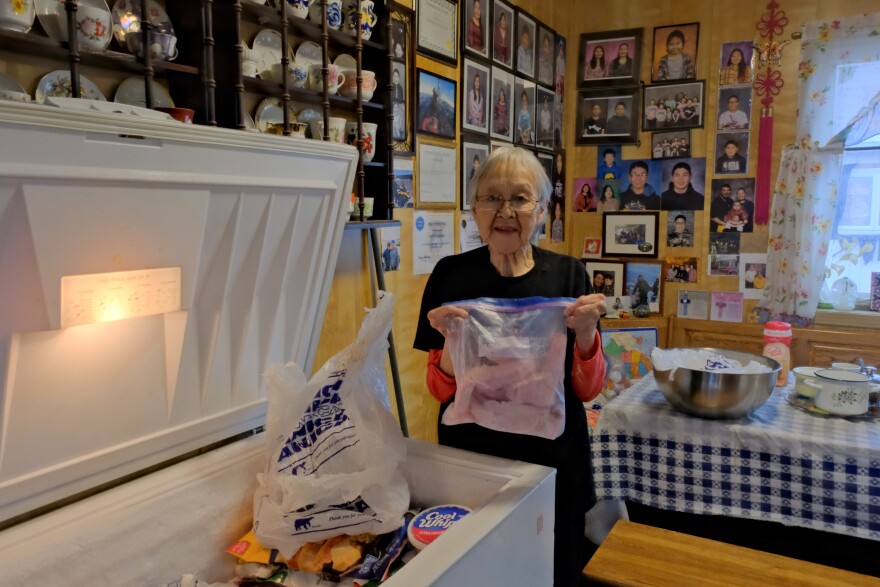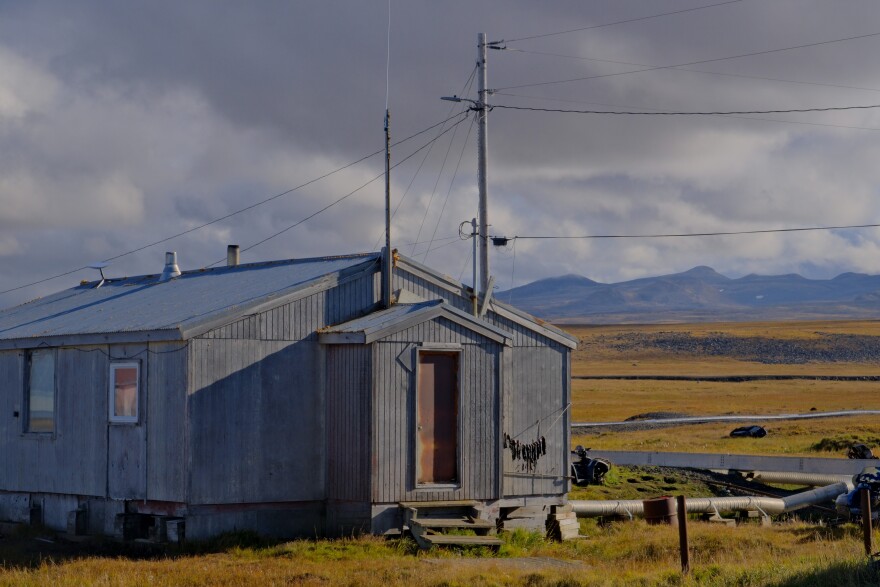This is the third story in a four-part series from the Alaska Desk called Shelf Life, which looks at food security in Alaska.
The Kookooligit Mountains, made of black volcanic rock, glistened behind Richmond Toolie as he rode his four-wheeler across the wet tundra outside of Savoonga. Ahead, the Bering Sea sparkled in the September sun.
A third-generation chief reindeer herder, Toolie paused as he crested each hill to spot the animals through his binoculars.
“All summer, there’s reindeer out here,” he shouted over the engine.
St. Lawrence Island sits a hundred miles west of mainland Alaska. It has two villages, Savoonga and Gambell. It’s also home to several thousand free-ranging reindeer.
Reindeer were brought to the island after a devastating famine in the late 1800s. At least a thousand people died — some from recently introduced diseases, others from hunger as strange weather disrupted subsistence hunting.
After the famine, a Presbyterian missionary brought reindeer to the island to serve as a reliable food source. In fact, Savoonga became a permanent settlement because of the proximity to the grazing grounds of the herd.

“It was a long, long time ago,” elder Larry Elaaq Kava said. “Sheldon Jackson brought in reindeer from Russia for survival. We might have another famine, and that helps.”
Since then, reindeer herding and subsistence hunting together have kept people fed. But residents say hunting has been less reliable lately. Now, as the changing climate disrupts old patterns, residents are turning to a new, commercial reindeer processing plant to shore up the food supply and bring in cash.
A reliable food source in a changing climate
Toolie, like other Savoonga residents, hunts various animals for food.
“Whaling, walrus, seal, reindeer, birds, fishing – all of it,” he said.
Riding across the tundra, he pointed out a whaling camp, fishing spots, and hunting blinds scattered along the coast – pieces of driftwood bound together to protect hunters from wind, rain and snow.

But hunting conditions have been changing. The Arctic is rapidly warming, and Toolie said that the sea ice around the island sets up later and is less stable. That’s caused disruptions to walrus hunting, a subsistence activity central to local identity.
“Back in 2012, both communities didn't get no walrus. Poor ice,” Toolie said. “So we gave all the households two reindeer each for both communities, Savoonga and Gambell.”
Kava, the local elder, said the warming climate also affects migration patterns for marine animals. Whales now travel near the village almost two months early or two months late, he said, so having reindeer on the island helps.
“That's really reliable,” Kava said. “That's our delicacy now.”
Each year, herders and hunters get permits and hunt reindeer for themselves and for others. The village also comes together to share reindeer meat during holidays.

At the farthest end of the supply chain
Poor hunts aren’t the only reason why the reindeer are critical to the island’s food supply. Residents say they rely on the herd when they can’t afford meat at a local store or when storms hold up food deliveries.
And now the community is working to transform that land-based subsistence resource into a more formal industry. Savoonga has nearly finished building a small-scale processing facility that will produce pre-portioned reindeer cuts available for sale.
The efforts to transform reindeer herding into a business started a long time ago. When the University of Alaska Fairbanks purchased mobile units for reindeer processing about 15 years ago, Savoonga residents adjusted some of their traditional practices and learned to use it, said retired University of Alaska Fairbanks’ professor Greg Finstad.
“To sell the meat commercially, you have to do things very different than what you did when you were producing meat through subsistence,” said Finstad, who led the training. “They wanted to really make it happen, and I'm so proud of them – they did make it happen.”

Then, about five years ago, the village reached out to a local tribal consortium, Kawerak Inc., and other partners to help them build their own meat processing plant. In 2022, the village received an Economic Development Administration grant for the work.
Alice Bioff, a business planning specialist at Kawerak, said that a business built around cultural values can be a great solution for generating revenue, especially at a time when federal and state funding opportunities are shrinking.
“This project, it was driven by the community,” she said. “Being as rural as we are in Northwest Alaska, at the end of the American food chain distribution system, it just makes sense to have reindeer as a resource up here and to turn it into not only a food security source, but also an economic development opportunity.”
Construction started this summer using pre-built modules bought from a Finnish company, similar to those used for reindeer processing plants in Russia, Finland and other countries. TBI Construction hired 15 locals – the majority of the workforce – to work on the project.
Work is scheduled to wrap up in the coming weeks. After that, federal regulators will need to certify the plant for commercial use, though the government shutdown might delay their visit.

’A lot better than steak’
In September, local workers put some final touches on the new facility, rearranging the refrigeration blocks and flattening gravel brought down from the hills.
The shiny modular plant stands by the beach on the edge of town, with a temporary corral overlooking the mountains. Inside, there are several rooms for cooling and freezing meat.
“Hopefully, that plant will evolve to inject more economics into the village,” said Perry Itegnaq Pungowiyi who is both a hunter and one of the local workers.
Once the plant is working, the plan is to slaughter reindeer about four times a year and sell the meat on the island. That’s according to Freeman Kingeekuk, the business director of the Savoonga Reindeer Commercial Company, a subsidiary of the village that will manage the new facility.
In the future, there might be a chance to sell meat to other Alaska villages as well, he said, though those plans are not set in stone.
“When we did those trial runs, we would sell on Facebook, and we couldn't keep up with the demand,” Kingeekuk said. “It's undecided who the market is, but I know there's a market for it.”

Locally, Pungowiyi is an example of what that market looks like.
Pungowiyi is a subsistence hunter and single father taking care of his youngest son and grandkids. Providing food for his family is not easy, he said. While he tries to stock up on subsistence meats throughout the year, he needs to supplement that with store food as well.
But when winter blizzards last for weeks, flights can’t come in, and the store goes empty, he said. Plus, imported goods are expensive.
“It would be nice to have our stores selling our local reindeer,” Pungowiyi said. “It's hard to afford that steak, It's like $50, $60 for a piece of steak. And to me, reindeer tastes a lot better than steak.”

And as Savoonga’s facility nears its opening, other villages are paying attention.
Nathan Baring, program director of the Kawerak’s Reindeer Herders Association, said that herders in several communities have talked about starting similar meat processing facilities – or just developing their reindeer industry.
“The whole region is looking forward to seeing their success with the project. I think it also provides a blueprint, in addition to inspiration, for how to do it in other places,” Baring said. “It is a huge step toward food security for the region, and certainly for the island.”


